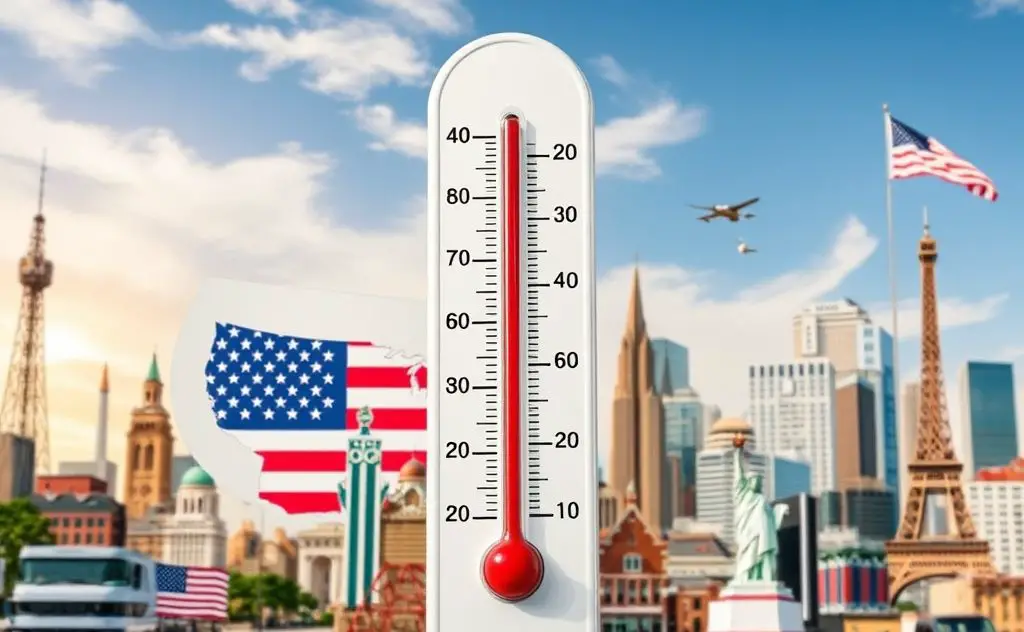The United States primarily uses the Fahrenheit scale for everyday temperature measurements, particularly in weather forecasts and household settings, while scientific contexts often utilize the Celsius scale.
The United States remains one of the few countries that primarily uses the Fahrenheit scale for temperature measurement. While most of the world has adopted Celsius as part of the metric system, Americans continue to measure weather, cooking temperatures, and thermostat settings in degrees Fahrenheit. This article explores the history, reasons, and practical implications of this unique measurement choice.

The Fahrenheit Scale in America
Developed by German physicist Daniel Gabriel Fahrenheit in 1724, the Fahrenheit scale sets water’s freezing point at 32°F and boiling point at 212°F. The US adopted this system during its colonial period when Britain used Fahrenheit, and maintained it even after Britain switched to Celsius. Today, only the US and a few small nations like the Cayman Islands and Belize still use Fahrenheit as their primary temperature scale.
Key Fahrenheit Reference Points
| Temperature | Fahrenheit | Celsius |
|---|---|---|
| Absolute Zero | -459.67°F | -273.15°C |
| Water Freezes | 32°F | 0°C |
| Room Temperature | 68-72°F | 20-22°C |
| Human Body | 98.6°F | 37°C |
| Water Boils | 212°F | 100°C |

Why the US Hasn’t Switched to Celsius
Several factors contribute to America’s continued use of Fahrenheit:
- Historical inertia: The system was well-established before metrication efforts began
- Cultural familiarity: Americans understand weather forecasts in Fahrenheit
- Economic costs: Changing all thermometers, appliances, and documentation would be expensive
- Voluntary metric adoption: The 1975 Metric Conversion Act made conversion voluntary rather than mandatory
Interestingly, some scientific fields in the US do use Celsius. The National Weather Service reports temperatures in both scales, and many infrared heating systems use metric measurements for technical specifications.
Practical Temperature Conversions
When traveling or using international recipes, Americans often need to convert between Fahrenheit and Celsius. Here are the exact formulas:
Fahrenheit to Celsius
°C = (°F – 32) × 5/9
Celsius to Fahrenheit
°F = (°C × 9/5) + 32
For quick estimates:
- Double the Celsius temperature and add 30 to approximate Fahrenheit
- Subtract 30 from Fahrenheit and halve it to estimate Celsius
Temperature Measurement in Heating Systems
Understanding temperature scales becomes particularly important when dealing with heating equipment. Many propane water heaters and other appliances display temperatures in both scales. The choice of scale can affect:
- Thermostat settings
- Safety cutoff temperatures
- Energy efficiency calculations
- Maintenance procedures
According to NIST, the US National Institute of Standards and Technology, both scales are equally precise for scientific measurement. The difference lies primarily in their reference points and common usage.
The Future of Temperature Measurement in the US
While complete conversion to Celsius seems unlikely in the near future, some trends suggest gradual change:
- Many new appliances offer dual-scale displays
- Scientific and medical fields increasingly use Celsius
- International trade pushes for metric standardization
- Younger generations familiar with metric through science education
For now, Americans continue to experience weather forecasts in Fahrenheit, set their thermostats for baseboard heaters in familiar degrees, and convert temperatures when necessary for international communication or scientific purposes.

